Zoos & Aquariums Final
Reintroducing animals
Theory
We manage threatened species with 4 methods
Removing other stressors
In-situ management
Assisted migration
Species rescue
In the last 2 - animals may be translocated
Translocation: movement of living organisms from one area with free release in another area
Introduction - releasing animals into a habitat where they have never occurred naturally (purposefully or accidentally)
Reintroduction - releasing animals into an area where they have declined or disappeared
Textbook definition: The release of wild-caught or captive-bred animals into an area where they have declined or disappeared as a result of human activities.
Reinforcement - restocking / supplementation of a population by adding individuals to it from elsewhere
Translocation success predictors: taxonomic class of the species under consideration, reproductive potential of the species, location of release compared to original habitat (historic range), legal status of the released species.
Assisted migration is currently being debated as something that can be incorporated into conservation / management plans to help species with low dispersal ability or that are otherwise sensitive to climate change to cope with future range shifts.
You want to eventually be able to stop investing time and energy into animal. Reinforcement and restocking can be like putting game fish back in. Put the through boot-camp to see if they survive (black-footed ferret).
Rehabilitation: Process by which naive animals are trained to live in their natural habitat (which needs to take place before they can be released into the wild.
Reintroduction can involve translocations of non-captive individuals, release of captive born individuals, release of wild-born but captive-raised animals or plants.
We translocate organisms - establish new populations, restore a damaged ecosystem, remove stressors, specific purposes (education, scientific research), protect animals / people from each other.
Biomedical research - primate colonies established in new, similar habitat for biomedical research purposes.
Often we use smaller organisms like fruit files or yeast. We can use animals to test medication on them. We have to do animal trials before human trials.
‘Nuisance’ animals translocated for safety: town dump has a lot of bears - not eating regularly on land since they need seals. They’ll try and trap them to intercept before they get to town. Polar bear jail - if they keep coming back. Make it a negative experience so they don’t come back.
To establish new population - successful reintroductions require release of many individuals over months / years ← is an adequate supply of individuals available for this. Avoid drift, inbreeding, other things. Need a lot of individuals. Very fecund - easier, but a long-lived mammal may take a longer period of time.
For plants - seeds can be collected and dispersed to new sites. This method has low success rate. Can germinate seeds then plant.
Three factors to increase success
Use multiple sites for translocations
Maximize the number of transplants
Reintroduce species over several successive years at the same site.
Many temperate or polar plants can overwinter as seeds - seed banks store these indefinitely.
Millennium seed bank project: Royal Botanical Gardens, goal is to conserve 25% of 250 000 plants in seedbanks by 2020. Provide people with knowledge. Zoos have better wild animal veterinarian knowledge.
Invasive species population persistence is more likely when there is reduced environmental variation.
ESUs: Evolutionary Significant Unit. The concept of ESUs was originally aimed at identifying populations with adaptive variation. ESUs are now defined based on their genetic distinctness, which results from reduced or absent gene flow between them and other populations. ESUs are identified through neutral genetic markers, which actually tells us nothing about the adaptive significance of any potential genetic differences.
Theoretical considerations
Types of release
Hard release: animals released from captivity with no training / no time to acclimate to environment
Soft release: animals given care at release point (spend time in cage at release point or fed and sheltered at release point)
Social groups that are given a hard release often disperse and fail to establish. We mostly use soft releases to increase potential for success.
Ecological setting for release: determined reasons for species decline, assess populations life history in a natural setting.
Life history traits describe - Reproductive strategies of organisms (how many offspring/when to reproduce), timing of life cycle events (how long to spend growing before mature).
Need to know lineage of organism, where population is historically released
Population persistence is more likely with large number of founders, reduced environmental variation, animal is herbivorous, founders have a high degree of genetic variation. Unless seasonality is needed - less year to year difference.
You have to pick a lifecycle stage - extinct in the wild. Figure out what they are.
Genetics of population(s): risks of inbreeding and outbreeding depression, past bottlenecks can impact present Ne, conservation management - maintain / restore evolutionary and ecological processes, translocations = artificial gene flow, IUCN guidelines prohibit geneflow between ESUs and other populations of species.
Maybe develop a meta population. Gene flow - is it a good thing or a bad thing. Should know before you do it.
Evolutionary species concept (ESC): a species is a group of individuals that share unique similarities of their DNA, and so share an evolutionary history. Is gene flow really a bad thing?
Local adaptation is good and you could lose them.
Problems with translocations
Allocation of resources - habitat restoration is necessary, cultural and economic factors play a role
Dispersal of release animals - Animals can move beyond reintroduce zone, sometimes animals return to previous habitat. Animals don’t have to stay where they’re put.
Environmental carrying capacity (K) - How many individuals can habitat actually support, K is difficult to determine, especially for animals that feed at higher trophic levels
Conflicts with humans - human activities can impede reintroductions. Captive-bred animals may not be afraid of humans (or even of other predators). Wolves had good reintroductions but humans killed them. Captive animals may lack fear. Animal may miss learning certain necessary behaviour.
Ecological disruptions - newly reintroduced species can be a major ecological disturbance for other species in an area. Increased competition / predation on other species. Community may have moved on.
Post-release monitoring problems - months / years of monitoring necessary. Without monitoring, can’t determine long term success easily / at all.
Captive-reared organisms can be unfit in wild - relaxed selection, adaptations to captivity, non-adaptive changes that affect individual fitness in wild.
California Condors: Reared in captivity, got numbers up, they didn’t know what species they were because they imprint on who feeds them - they were trying to mate with humans. They would keep coming back to species - they imprint on where the nest is. They learned to start feeding them with publics. They raise condors in enclosed outdoor areas far from buildings.
Reduce interactions with humans and with human-dominated habitats, wild-caught individuals can be used to train captive-reared ones, headstarting can be used to avoid genetic changes in captivity, but does not prevent non-heritable changes
Need suitable habitat, animals might move beyond the reintroduction zone, captive-bred animals may not be afraid of humans or of predators, translocated animals may become invasive, which could lead to problems for other species in the area.
Application
The goal of species reintroduction is to establish a healthy, genetically diverse, self-sustaining population to an area where it has been extirpated, or to augment an existing population.
Zoos responding to the conservation crisis - Puerto Rican Crested Toad, Blanding’s Turtle, Eastern Massassauga
Early maian role of a lot of zoos has been a menagerie or form of entertainment. Hunting bison is not sustainable practice - we need to help the population and add to the zoo collection. Set zoos on their active role of conservation.
Zoos help with education, scientific research, conservation (ex-situ / The Ark, and in-situ)
Preserving animals in their habitat is the idea - habitat protection, restoration, connectivity (landscape level changes, fewer pristine places, 83% of earth is impacted by humans, increase demand for resources and space, and climate change). We can’t always manage populations, we have to do habitat restoration stuff. Human population growth makes this shit difficult.
When preserving he habitat is not enough (depleted habitats and protective custody to prevent extinction). Sumatran Tigers are 400-600 left and not viable in situ. Carnivores are difficult to reintroduce.
IUCN has identified 47 000 SAR - Zoos have space for a few hundred, what we can save is worth saving.
Zoo has limited capacity for working with animals in specific ways
Number of species - too many to help any in a meaningful ways. Re-evaluated their program. Fingers in too many pots.
We need zoo animals more than ever - extinction rate is 211 times background rate. Amphibian is a bioindicator species and with changes in habitats we see similar issues.
Modern Zoos are conservation and welfare focused - conservation and welfare ethic - maintain and promote species diversity and health of ecosystems, highest quality care with direct wildlife and habitat benefits. Animals rights focused on individuals. The rights of an individual can inflict harm on other animals. Right or liberty of individuals could lead to species disappearing.
Zoos are a Safe Haven - Animals tend to live longer in captivity, and a lot of populations become geriatric which they wouldn’t in the wild.
Animals in Assurance Colonies
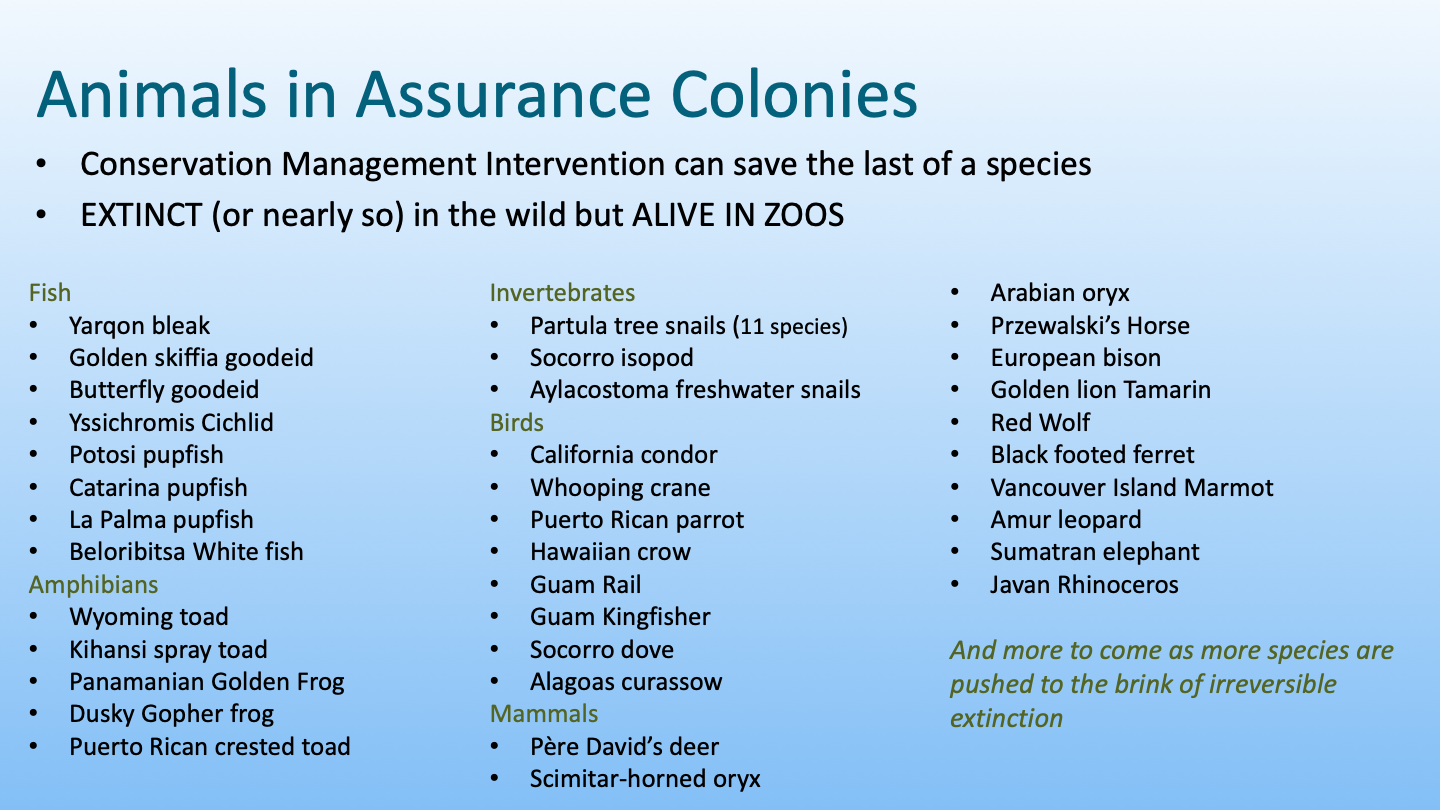
Animals still alive in assurance populations, but wouldn’t persist without zoos
Ex situ assurance - assure we will have genetic material and animals left to reinforce, re-establish and revitalize. Works through basic different translocations.
Where do we get animals - Individual or population rescue, populations that faced immediate threats, individuals from confiscations of illegally held. Imported or trafficked animals. Blood samples from everything, analyzing genetic markers to figure out where they came from, may be able to put them back in area where they came from.
Co-operative management strategies - due to limited space, human and financial resources available, a co-operative strategy for managing captive populations needs to be used. AZA Species Survival Plan (SSP) and Saving Animals From Extinction (SAFE). EAZA has European Endangered Species Programme (EEP). Comprehensive approach that ensures captive populations have the best chance of fulfilling their conservation potential.
They were able to get a lot of species to reproduce naturally and successfully in situ. Long-term In Situ conservation projects.
Dusky Gopher Frog
500 IU hCG and 15 ug GNRH subcutaneously morning of collection. Spermic urine collected every 30 minutes for a 3 hour. Stored refrigerated. Assisted Reproduction.
Conservation translocation: the deliberate movement of organisms to a new location to help conserve species and ecosystems.
Reintroductions: inside its natural range, to areas where it has been lost
Reinforcement: into an existing population within its natural range
Assisted colonization: to benefit the conservation status of the focal species outside its natural range
Ecological replacement: outside its natural range to perform a specific ecological function that has been lost through extinction of another organism
The goal is to establish self-sustaining populations in situ. Assessing translocation success - successful reproduction, dispersal patterns, genetic diversity, itegration with existing population, population growth.
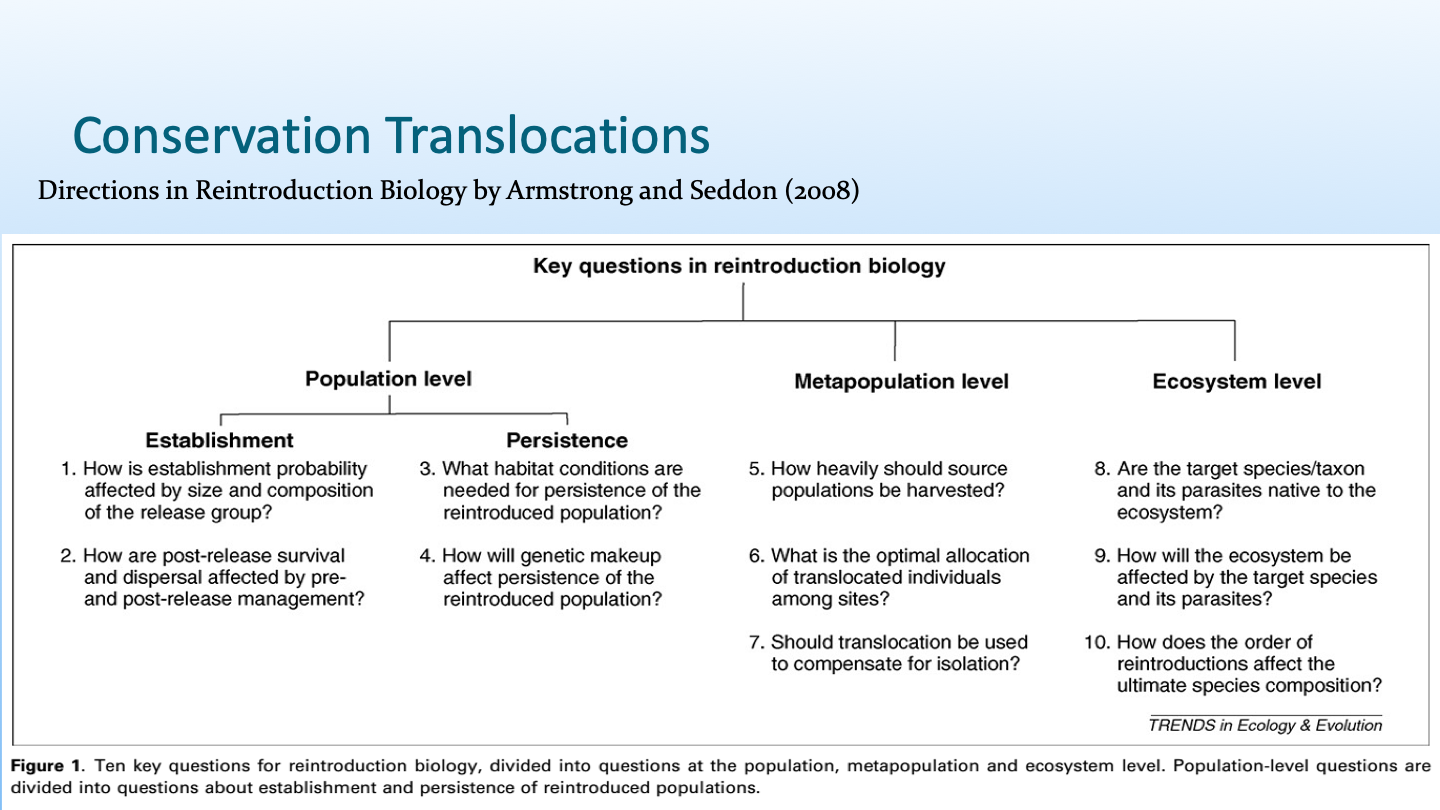
Feasibility: can the species be saved? is the source/assurance population viable? Do the facilities and expertise exist? Does the sufficient protected habitat exist? Have threats been mitigated?
SSPs facilitate recovery in situ. Conservation translocations are an important tool. Used in conjunction with other strategies - education and research, habitat restoration, capacity building.
Puerto Rican Crested Toad
Critically Endangered
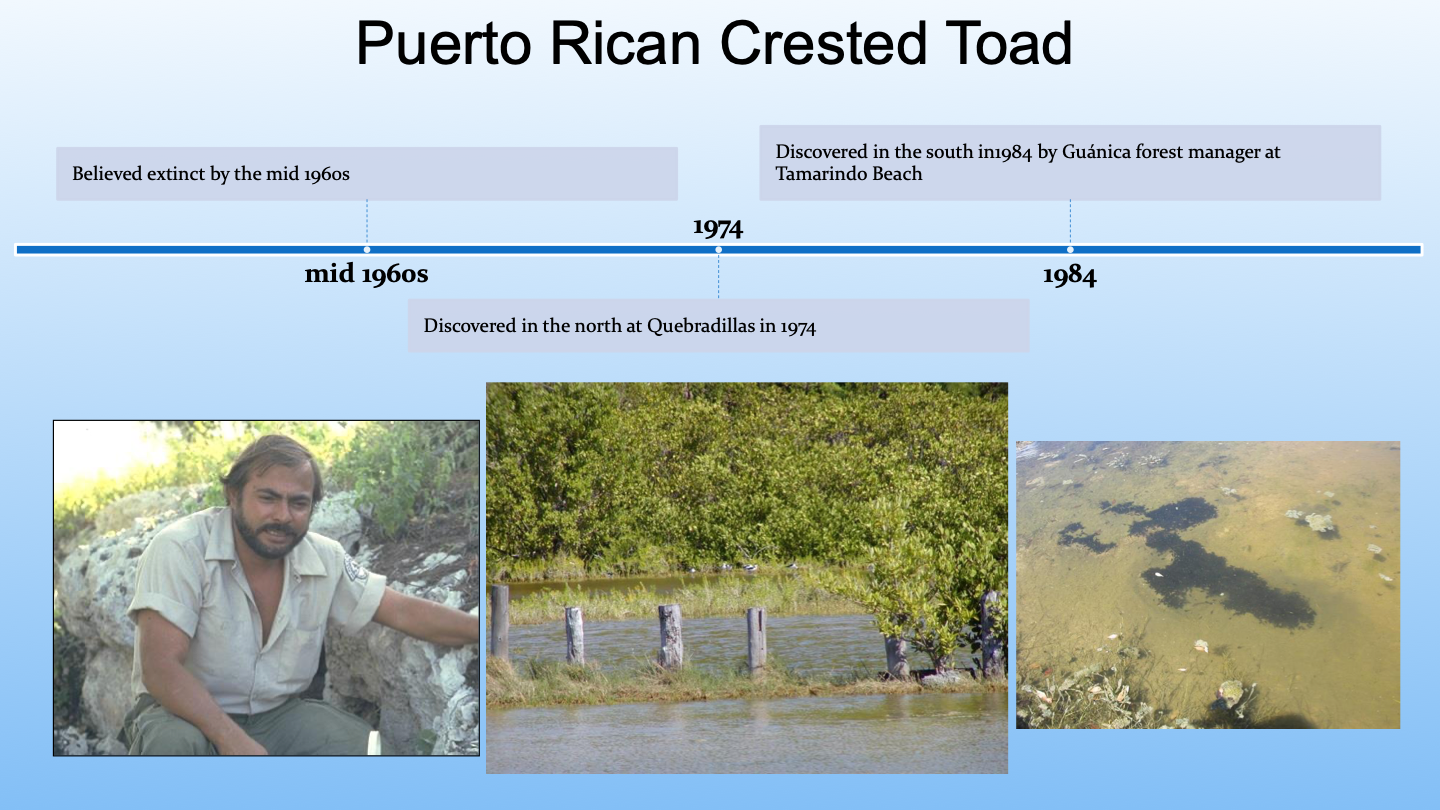
Toads were breeding in farm animals cattle troths. Beach population breeding pond during hurricane.
At risk of extinction in Quebradillas (no natural ponds) (North) and Guanica (single breeding pond) (South)
Ex situ assurance population established in 1980. Did we violate individual animal rights? Did we save a species? Source population for reintroductions.
Sustainability action in zoos
“The greatest threat to our planet is the belief that someone else will save it” - We expect people to step in. Advocating for assistance from the zoo works against this.
Conservation is about animal related issues - some include natural resources and sustainability as well, today is just animals
Environmental sustainability - reducing ecological footprint and use of natural resources
Green initiatives - actual activities and implementation in reducing overall footprint
They’re trying to focus on biodiversity, how we utilize everything has direct impacts. To not use this. Sustainability is apart of that question. We need to educate and show its possible in everyday life. Advocacy of sustainability and active in global political efforts.
Beyond animal welfare, environmental stewardship, and inspiring change
Go above and beyond animal welfare issue - horticulture and plants are important - conservation of biodiversity, not just animals.
Net zero plan - waste water and energy by 2030
Connect science and people. For sustainability plan, our zoo operation provides a positive zoo benefit.
Key environmental issues zoos & aquariums address:
Habitat destruction - sustainability through restoring habitats
Pollution control - relates to climate change and loss of biodiversity
Climate change - used to set goals
Biodiversity loss - in order to be successful in conservation targets, we need to look at the ecosystem as a whole. No society does not benefit from a healthy ecosystem.
Sustainable Practices
We see energy conservation, water conservation, sustainable architecture, and waste management are sustainable practices in zoos.
Energy conservation
ICEnergy Systems - offsets electricity use to off-peak hours, powers air conditioning in Caribou Cafe
Does not reduce energy consumption, but offsets use of electricity to daytime peak to off-time off. We help with technology sale - testing in zoos.
Geothermal - reduce carbon emissions by 230T annually, use of renewable energy makes habitat carbon neutral.
Wasn’t tried widely yet.
1.3 million people come to the zoo, this is a guest experience - go in and touch the system. Creates heat in habitat states. Geothermal maintains habitat space and educates. Make carbon neutral - generate renewable energy for the Ontario hydro.
Infrastructure upgrades - VFDs, On Demand Water Heaters, High-Efficient Boilers
Worked on making buildings more efficient
VFDs - different systems, modulate use of motors, which are designed to be on or off, power can now be 25% to 50% to whatever % off.
Water heater - Heats as it gets there, doesn’t hold the hot water. Cool and heat while on demand. No misused electricity.
High-efficient boiler: retrofitting system is very efficient. Designed and built for our building. Wide range needing accommodations. Reduces margin of error. “you have 95% reduction” → “treat it as 80%”
Fibration media - Recycled glass media, reduces water consumption, energy consumption, and waste.
We use glass medium, filter it. Once transition to glass, we never have to replace it, we just fix it up (cheaper). Sand compacted creates holes, which reduces filtration capacity - stop nitrogen cycle.
High-Efficient technology - air-source heat pumps, 162 tonnes reduction in emissions, 87% reduction in natural gas consumption
Adopted heat pump technology - sucks up heat energy and release it, using electricity and not natural gas. Energy can be generated in multiple renewable energy forms. 5 electric heat pumps can run entire tropic pavilion.
Expecting an 82% gas reduction, we hit 97%. Increases welfare, lowers hydro bill, sustainability.
2.8 MW solar array - powers 330 homes, reduces carbon emissions by 1284 MT
Cincinnati zoo, end of last year - installation of solar panels, it is now carbon neutral - could power 330 homes.
We’re going to improve efficiency of buildings we have, large scale solar implementation is the only way we can reach net zero.
PVC - photo, newer generation of solar panels up there
Thermal photo cells (panels) - old type, heats water running through the system
The workers need to shower - 187 people taking a shower at the end of shift in 4 hours - need to leave uniforms home - shouldn’t be bringing any potential diseases home.
Water conservation
1/3 of the zoo’s water usage is for animal husbandry (pool, aquarium), another 1/3 is visitor washrooms, and the rest are staff activities not related to zoos, like garden watering and stuff.
In 3 years the zoo exceeded target of water cut down by 19x or whatever - changed how staff did their job, no changes to infrastructure or significant tools, just education. When you put the hose down, turn the tap off.
Rain capture - 21 000 L cistern, 81 000 L water reduction
Most effective project was an automatic load system - all bathrooms low flow automated system.
Some rain capture systems have a very small drop in bucket to be used in greenhouse every year. Dollar value of zoo plants greater than animals, important for maintaining horticulture. Be able to use water to clean animal habitats. Eliminate potable water will make a big change.
Elephant Trek - 1 M gallon rain collection and storage, first zoo to obtain net-zero water
They use rain catcher for water and habitat pools. How can we take untreated water and use it - take to a water quality testing lab.
Potable water vs. rain water - it’s not what can we do with it, we have the technology, we just need to prove it’s safe.
California takes San Fran sewage water. People care about animal health, but even more about human health.
Floating wetland - 5% surface area coverage, improve water quality, greywater use
70% of fallen water lands in ponds - populations in zoos did not manage ponds, in horrendous conditions, but they’re working on it.
Plants naturally filter water. Not just looking at man made technology and how it’s working, how can we simulate that.
Sustainable architecture
LEED - Leadership in energy and environmental design, standard practice for all construction
Net-zero construction, certification process, get building certified to sustainable threshold. More natural, nature based solution, with newer stuff. Energy efficient homes so energy is saved from the very beginning.
LEED good for large scale building. Not at Toronto Zoo, but rather at the Cincinnati zoo - rule to get any building to be certified at LEED gold standards. They hit platinum.
Community Conservation Campus - opening 2026, carbon neutral construction.
Will be the first thing guests see. Best we can get.
Greenhouse Retrofit - 40% reduction in energy consumption, 64T reduction in GHG emissions
Reduce with natural stuff, tackling things one at a time and making huge headway.
Waste Management
Towards a circular economy
Certified
Relies on public education, easy to educate staff but with 1.3 million guests, it’s difficult.
Circular economy: we will eliminate landfill. Our product will deteriorate and die. Recycling over and over again. Reduce, reuse, recyclce.
A person who is capable of recycling well mess up 5% of the time when at home. When in public that drops to 23%. You have 3 seconds to decide.
Partnerships may have benefits
Coca Cola barrels of syrup - when they empty barrel, it’s garbage. At zoos, it’s a great toy. Coca Cola donates the barrels to the zoo and it enriches lives of animals. Design contests
Introducing “friendlier containers” - bumped up in 2024, along with plastic saved, GHG emission prevented, and litres of water saved.
Diverse practices in waste management
4361 cellphones and 10 946 kg of electronic recycled. 20 alternative waste recycling programs. 12 168 kWh of renewable energy produced from Zoo waste, and 2690 cellphones collected during the Gorilla on the Line Campaign.
Green initiatives in zoo operations
Sustainable food sourcing - all sustainable palm oil
Eco-friendly visitor experience - EV charging statement for guest
Green transportation - commuters emit 320 tonnes of GHT emissions
Green transportation
Electrification projections of zoo fleet doesn’t help much with commuter numbers though
SARIT Micromobility - 3B partnership
Community engagement & public education
Green visitor program, public awareness campaigns, partnerships with schools & conservation groups
Embassador focused conservation
Very specific issues and how to resolve them - simple reliable changes for guests
Invasive species management and Biodiversity restoration projects
12 579 volunteer hours committed to climate resiliency in past three years
Phone apes - amount of stuff mined in the Congo has destroyed the ape habitat - with recycling it can be reused.
Majority of palm oil production is in Indonesia - we show orangutans as the face of the issue
Support sustainable palm oil, replace it with soya bean and canola oil.
Public education through signage and stuff
Value orientation → knowledge of adverse consequences → personal norms → sense of responsibility or moral obligation → action
CO2 Emissions
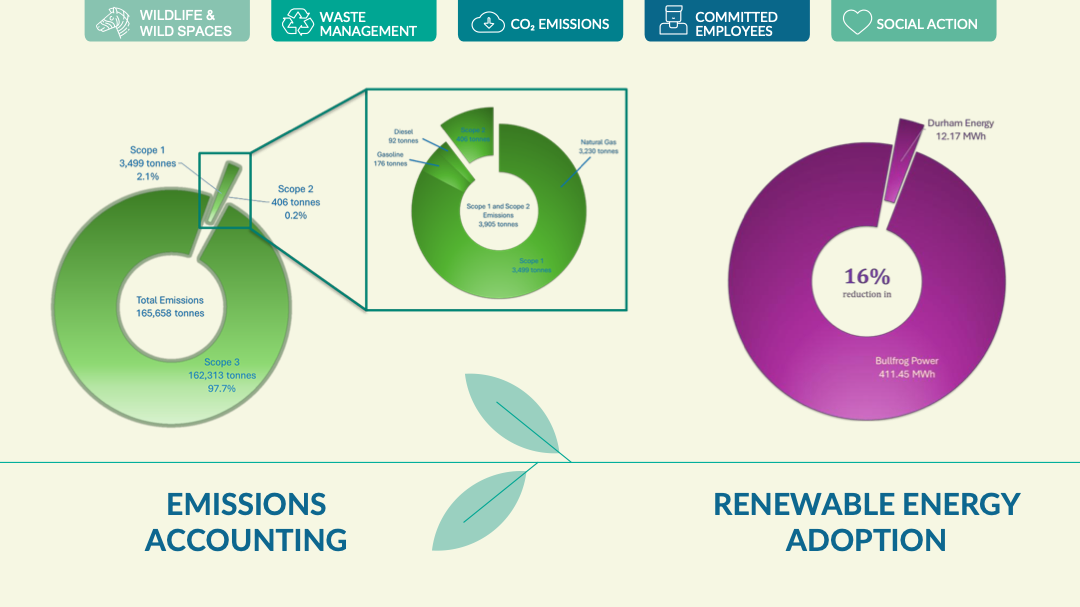
Committed Employees
They participate in education of themselves and others, create signage, etc. Participated in the global climate strike. Engagement, conservation action, environmental stewardship, our green eco-zoo team (GEZT).
There are future directions and challenges with financial constraints, animal welfare vs. sustainability, and technological advancements.
Educating the Public
Connecting people to Nature and Inspiring Active Stewards of Wildlife Conservation
Educating the public
Allowing for petting animals could teach people that exotic animals may make good pets, or that it’s okay to get close to wild animals (even dangerous ones).
There has been a shift in how adults and kids spend their time - there’s been a disconnect with nature. Choosing to spend more time indoors than in nature.
This could be due to many reasons
Busy schedules & devaluing of nature - not a lot of time for exploring nature together
Technological advances & lures - screen time taking away from outdoor play time. 44 hours a week - only about 10 minutes of outdoor play time.
Fear - stranger danger, ticks, etc. Parents can’t protect them always.
Increased urbanization - Populations are going up and more housing complexes are too - we either need to kill people or accept cities. Nature isn’t a need to have, it’s a nice to have.
Nature-deficit disorder: Way of viewing a problem, human costs of alienation from nature - diminishes use of sense, attention difficulties, and higher rates of illness. Not individuals, can affect everyone.
Ecophobia: A feeling of powerlessness to prevent cataclysmic environmental change
When children provided with knowledge too abstract for their age, or content they are powerless to correct
Overwhelming feelings of doom and gloom, don’t place the stress of nature on the kids. We need them to love it to save it.
When we communicate messages:
Babies love animals
Kids can learn environmental manners (don’t litter)
Pre-teens can learn simple environmental consequences - recycling good cuz landfills bad.
Teens can learn exciting stuff but also more serious concerns. Leave things on a positive note for them still.
Benefits of nature - free play in natural areas enhances children’s cognitive flexibility, problem-solving, creativity, self esteem and self discipline.
Can be any greenspace, garden, not just forests in the middle of nowhere.
Parx program brings people to places like the zoo to relax and refresh
Children who have meaningful experiences in nature are more likely to take action to benefit the environment as adults
Good role models and good direct experiences in nature
Meaningful childhood experiences in nature, more likely to take action as adults
IUCN - connecting different programs and groups, the more people experience, connect with, and share, there will be more action of people wanting to conserve it
Toronto Zoo’s Guardians of Wild Strategic Plan
Connecting people, animals, conservation science, and traditional knowledge to fight extinction. A world where people, wildlife, and wild spaces thrive.
All AZA zoos see over 200 million guests annually. More people know, more people try to help.
Conservation education mission: Toronto Zoo will engage communities by providing the tools and knowledge to connect to nature and protect our natural world
More than relaying information, equipping them with tools and knowledge to act as tools for saving the planet.
Ways zoos could make behavioural changes towards nature:
Zoos need to be market themselves as an important resource for their local communities
Zoos should train interested staff members to act as educators
Zoos need to tailor their programs to the specific types of visitors they get
Zoos need to come up with specific conservation activities for its visitors to participate in
Education aims of the UK zoo forum 2008:
To encourage public understanding of conservation issues
To excite, enthuse and interest people in the natural world
To provide experiences for visitors to enable them to make choices about their impact on the environment
To develop public support and action to address conservation issues
Examples of zoos participating in in-situ conservation:
Heidelberg Zoo helped establish an organization that trains staff from other organizations as part of long-term protection of endangered primates in West Africa
Chester Zoo purchased a bus for rural schoolchildren to use to visit wildlife areas in Kenya and learn about the environment and conservation
Buenos Aires City Zoo, in an effort to get the local community involved in the conservation of a native wolf that is declining, started educating the public about the wolf and its threatened status
Werribee Open Range Zoo asked students to develop wildlife education resources that could be used for Zimbabwe conservation education
Understanding Learning Theory
People learn theory with little real-world application, but the visit to the zoos can make it more real. Science technology society and environment - STSE, not at the high school level, while recognized as important, the K-8 curriculum started doing STEM related to the real world.
Learning theory (epistomology):
Behaviourism: Teacher centred, learning occurs through external influences and memorization
Some sort of reinforcement of behaviour - like tests or quizzes.
Two main types
Classical conditioning: learned behaviours that are automatic based on the presence of a stimulus
Operant conditioning: learned behaviours that are voluntary and strengthend based on repetition and reinforcement
Law of extinction: lack of reinforcement makes behaviour happen less
**
Constructivism: student-centred learning occurs through guided experience and exploration
Group work, problem solving, participation. Science class works together to test the hypothesis. Increasing the shift to student centred learning. Even in math. Better cognitive skills.
Through the processes of accommodation and assimilation, individuals build (construct) new knowledge from their experiences. Assumes that individuals have previous conceptions of the world that form their reality, whether right or wrong. Taking prior knowledge and applying it to what is happening in front of you.
Individual imposes meaning on the world rather than meaning being imposes on the individual.
Really want individual to find learning on their own, with teach as a facilitator. Memorizing facts is good, but real world problem solving needs more.
May occur in the face of new knowledge:
CONFLICT BURIED: They will ignore the conflict between this new knowledge and their prior knowledge (ecophobia)
CONFLICT FACED: They will construct a better model from their prior knowledge
CONFLICT DEFERRED: They will temporarily push aside their intuitive prior knowledge and be open to learning a new way of thinking of their experience. Negotiation.
In the zoo setting, people can choose to participate or not, we always naturally practice constructivism. Problem solving more important than knowing your times tables.
Experience should be authentic, based in real world, and designed to be achievable (solution).
Authentic science: get everybody to be a scientist. Frogwatch and turtle tally - learn to identify and track, just as you would with iNaturalist. Need to know the frogs in real time. Not just memorizing, really connect and take information more memorably.
Free-Choice Learning & Interpretation
Choose whether you want to engage in learning or not
Learning = making meaning
Characteristics of learning in free-choice settings: guest-centric, episodic, continuous, affective, visual/physical, social, distracted, influenced by their reason for visiting.
Learner guides the experience, get them to interact. You have 60 seconds, make it count. Emotions play a huge part in learning.

Fits with constructivism. Zoo experience is compromised with a bunch of different contexts. What attitudes and beliefs do you have. Your family and cultural background influencing. Zoo educators only affect the physical context. Watch kids, make sure they don’t get lost. Get people involved.
Personal context - Prior knowledge, values, beliefs, attitudes, emotional state, reason for visiting.
Guests at zoos typically know things, so we meet people where they’re at. See themselves as part of the solution. Arrive with specific motivations that impact how they conduct their visit and what they take from it. Memory is a good proxy for what learning may occur.
Visitor taxonomy
Personal curiosity - is interested and thought they would like it (explorer)
Desire to facilitate other’s needs - others in group would benefit (facilitator)
Desire to see and experience place - it was an attraction or thing to in this comumnity/reputation (experience seeker)
Specific knowledge-related goals - relates to work or something I’m actively invested in (professional/hobbyist)
Seeking contemplative or restorative experience - to feel refreshed, focused, appreciative (recharger)
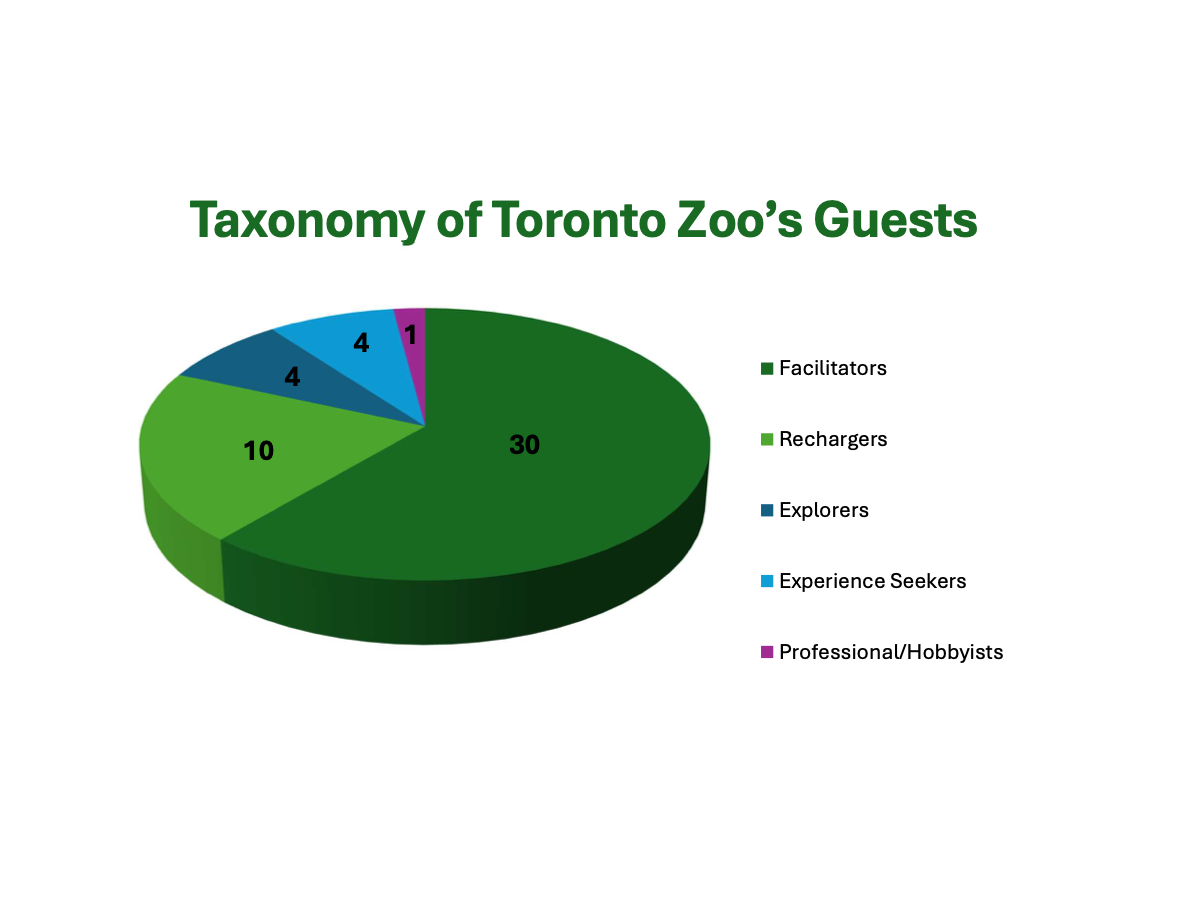
We risk overwhelming people with too much information - hands on original novel experience is best. Techniques are constructivist in nature drawing on first-hand experiences, original objects, and illustratice media and engaging people in personal, social, and physical contexts.
Key principles of interpretation → provoke (I’m curious), relate (I understand), reveal (I care)
Orangutan hotspot - sample nest and costume. Teach parents, excite kids.
Full size male cut out of tiger, you understand scale of it.
Get close to coyote fur, touch stuff, teeth. Mini career game kids create a fake meal on the other side
Let kids play with natural materials like bark (nature play)
Linking pieces together
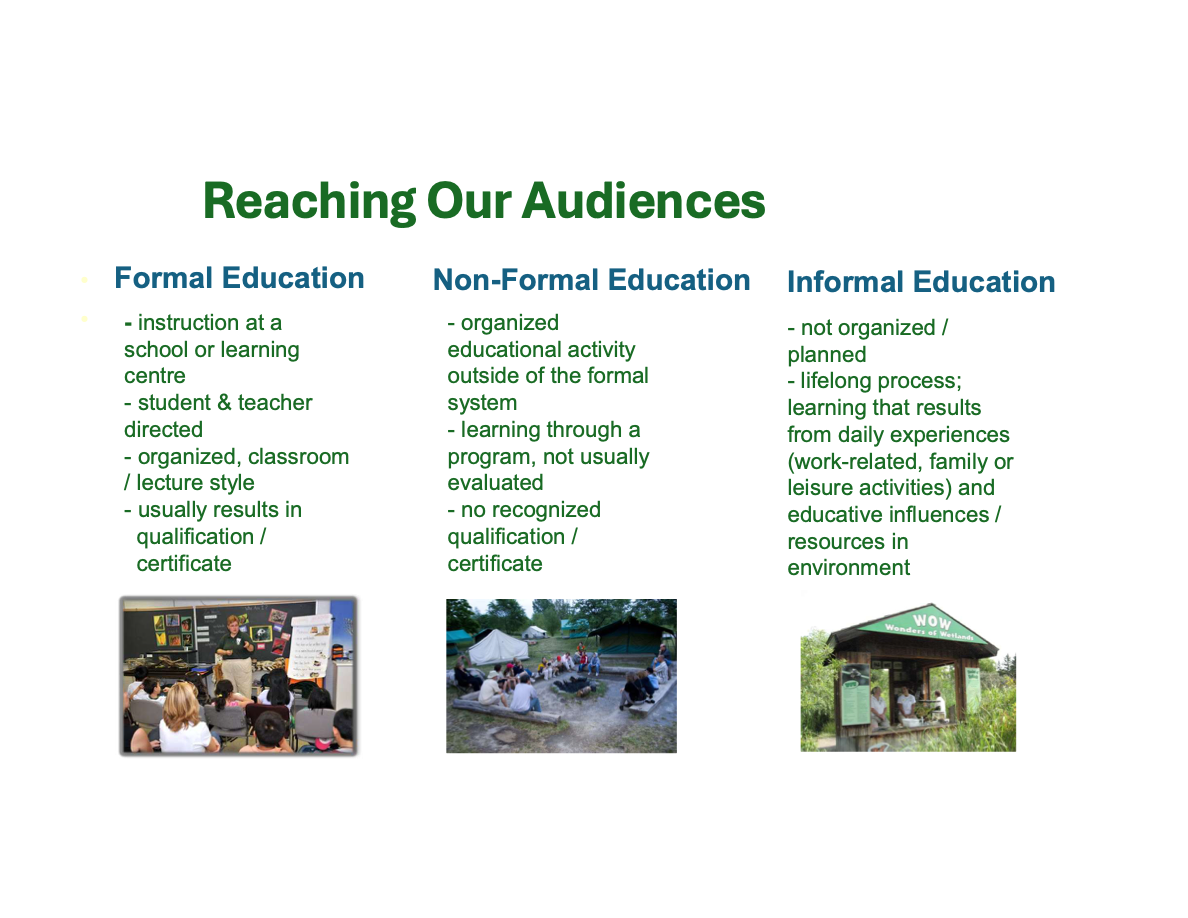
Informal: Taking things in, can lead to learning.
Outcomes: awareness, attitude, knowledge, skills, behaviour. Look for indicators of the outcome.

Ultimately leading to wanting to take action. Where they’re at in terms of steps. The more you know, the more you’re comfortable with. We want to help. Caring is for when you’re emotionally invested. Conservation is a team sport and we need more players.
Research at the Toronto Zoo
Wildlife health - a role of veterinarians in Conservation Science
New strategy - we envision a world where people, wildlife, and wild spaces thrive
Mission: connecting people, animals, conservation science, and traditional knowledge to fight extinction.
Trying to have a guest science conservation program in operation
From place to purpose: we are zoo funded by guests, species matter. Transition into very good conservation science organization.
Zoological medicine - The European College of Zoological Medicine (ECZM) is a European Veterinary Specialist College formed under the auspices of the European Board of Veterinary Specialisation
The College encompasses the following specialist areas
Avian medicine, herpetological medicine, small mammal medicine, wildlife population, and zoo health management
Professionalization
We are making it possible to have people be better professionals, really make something out of it
He did a masters research project on anaesthetic risk - humans only have a 0.00005-0.1% chance of death, while cats and dogs are up to 0.3% chance, horses are 1.0%, while great apes have a 1.35% chance.
Wildlife health impacts
Not about
Making wild animals “better” or the individual animal (too close to domestication)
Eradicating diseases or pathogens
Limited to infectious diseases
Limited to veterinarians
Is about
Preventing biodiversity loss due to disease
Reducing health and welfare risk to wildlife from people
Building an international cadre of wildlife health professionals
Establishing global centres of excellence in wildlife health
Pathogens and host conservation in a healthy dynamic. Limiting catastrophic events
There are zoonotic diseases like shingles. One animal was given chicken pox by a zookeeper. It’s the virus that stayed in the body till she was older, and informed us about how we look at great apes.
Longevity
Learn a lot about lifespans - seen it gone up in cheetahs. Good proxy measure for animal welfare
Lifespan equality, more likely to die yound with issues (disease, nutritional issues)
Big datasets are greatly beneficial
Establishing best practices
Monkeys may die at UV light exposure
Identical nutritional proposition - all about food presentation. Polar bear sees drop in stuff. Massive increase in energy reform.
Genetics: maintaining genetically viable populations
Can be an issue with small populations - coming from few founders
Malformed cerebellum
Translocations: breeding captive relations as an insurance policy, to introduce back in
Bacteria and microbacteria - responsible for tuberculosis, can cause infections in reptiles and snake fungal disease, really big issues
Snake are contaminated, suppressed. Reintroduction only possible after checking for disease threat.
Think about all the pathogens and all problems, holding everything accountable
Domestic animals:
Increasing interface between domestic animals and wildlife
We vaccinate big cats with same things as small cats
K9 viruses can go from a domesticated dog to a leopard. This is problematic - Do we vaccinate everything since this would interfere with other things.
Pandemics
COVID-19 affected wild animals in zoos
May not be an issue, may be an issue. Depends on closeness (relative) to humans. H1N1 bird vaccine, peak of bird flu had death.
Zoos are critical.
One health
How health of everything (species, environment, us) is intrinsically linked
14 million birds across Dehli and they were decimated very quickly due to a drug used in cattle (anti-inflammatory). Hiding a toxin - they got hemophilia and died within days.
Side burials stopped working, no vultures would come eat. Roaming dog population exploded - increase in dog bites and disease
Emergency response - brought birds into proximity (pairs to breed). Establish normal blood results.
Neurological issues with birds from captivity - had crazy bird flue. Neurological development slowed in captivity
Show wild vulture to captive vultures
Biobanking
Preserving genetic material. Wasn’t the way to be spending money - they thought we should just focus on what’s in zoos, but we’d lose the races if we did it that way
Gene editing might be crazy, can’t adapt in this lifetime though
35 year frozen sperm was inserted into female - extended the lifespan of the animals
Wildlife nutrition research at Toronto Zoo
Early History
In 1892 and 1903 we thought it might be best for carnivores to eat whole prey
Dr. Corsen White (1920s) - She found some of the monkeys in captivity were developing chronic diseases - multiple fractures they couldn’t recover from
She wanted to find a nutritional problem relating to these issues. She fed them to rats and rats developed the same disorders.
We discovered vitamin D in cod liver oil and they stopped eating their mates and saw similar results of healing.
Developed a zoo cake - lots of animals ate the same thing - gaining vitamins and minerals, widespread different species.
1930s-1940s - Huge boom in agricultural research
Fur farming industry really boomed, taking care of a lot with significantly different pressures. Get animals to an age they can be humanly euthanized.
Adding pet food and commercialization. Further research helped and the understanding of amino acids did. Starting to bring animal in specifically for research
1950s-1960s - More interested in improved health, disease resistance, nutrient requirement, and economic feeding (least cost)
1970s - TZ first to hire a nutritionist, then the Smithsonian zoo followed suit setting the precedent. 1980s is when it started to be more common and have.
Fundraising arm ZWNF - good for training of the next generation of zoo nutritionists. No proper accreditation, but there is a residency necessary. Toronto Zoo trained one in 2020. Very small field, but is a pathway to increase training.
Modern Approach
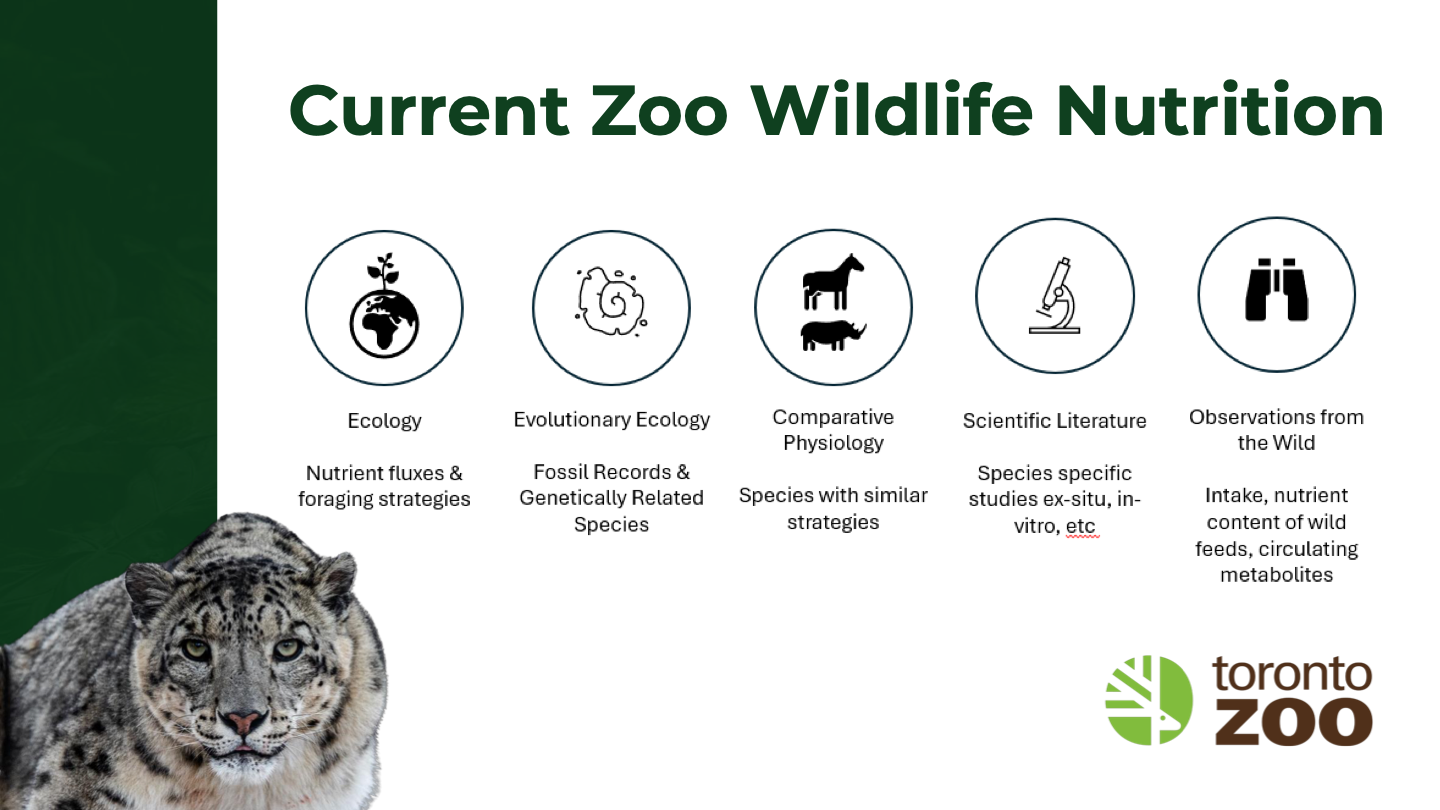
Evolutionary evology - related species still alive today help us understand. Sloth diet. Herbivore. Lots of sanctuaries to study. We can learn how to care for orphans.
Modern nutrition research helps enhance natural behaviours. Incidence of positive behaviours and what we can see. Time budgets help raise animals.
Natural diet composition is being studied, a lot is higher than we though in the wild diet, and thus we needed to edit stuff.
Circulating metabolites - active and wild species. Fixing vitamins. Led by zoos, how we can better feed animals, essential nutrients, alter diets to improve.
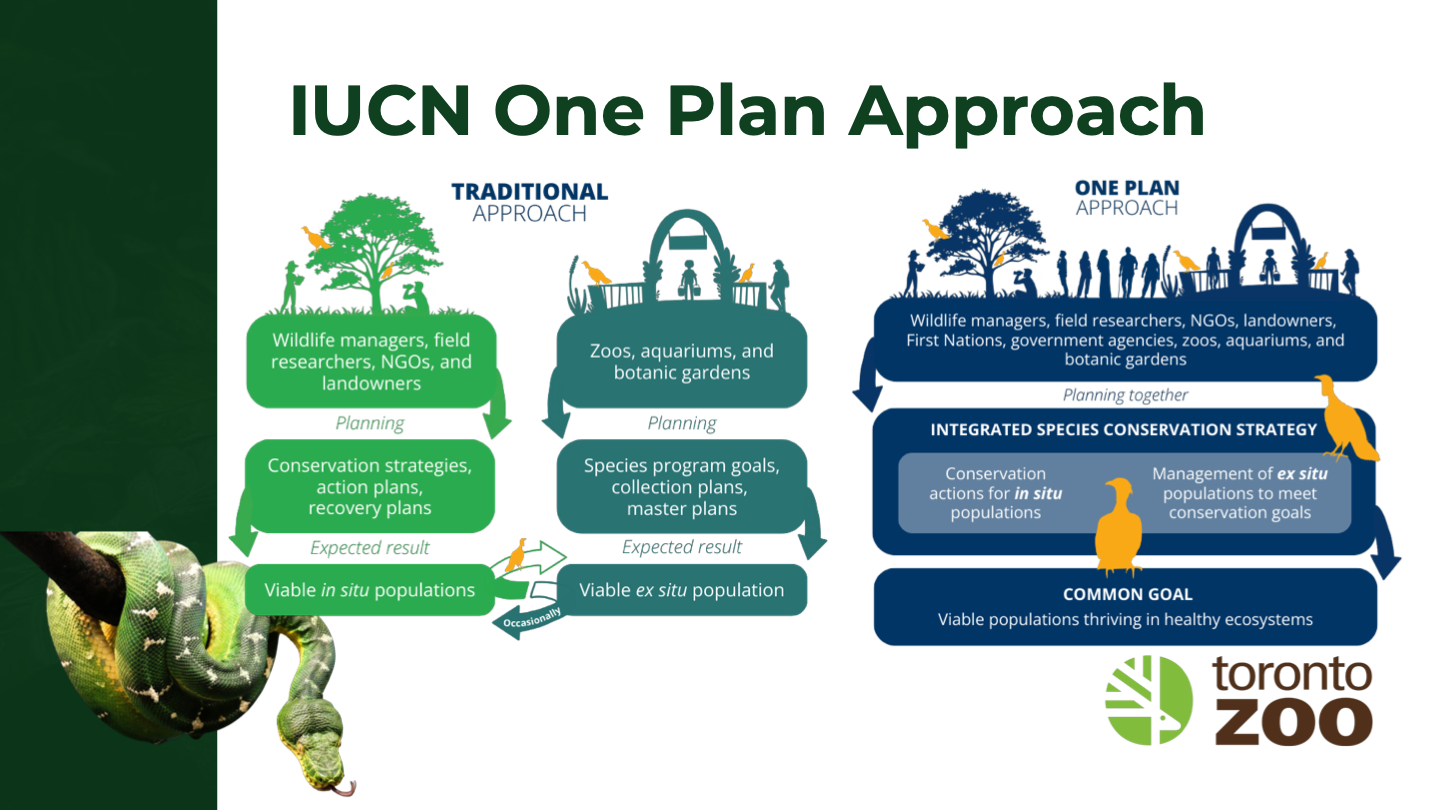
An ecologist or nutritionist may not have the same background, but may be able to combine their stuff and background to cover it.
TZ Nutrition Research (Vancouver Island Marmot)
15 species worldwide - 4 in Canada.
May not have as much resilience - reduced gene flow. We know some stuff about other marmots, but not these ones. Only about 300 left, in the 90s it was estimated at 30 left.
They are a hibernating species (alpine), snow pacts are very tall. They go into hibernation to conserve energy.
About 30 sub populations, active and presently inactive sites spread across the mountains. More habitat fragmentation used for surviving. Degradation of the land leads to a destruction of habitat, and the primary threat is the Vancouver Island Marmots. Roads and pathways reintroduce predators.
Forestry (logging), predators (more readily moving), late maturity (3-4 years), and frequency of reproduction (every other year to 3-4 pups).
VIM Knowledge Gaps: BW & Body Composition (prior to hibernation), wild type diet, captive diet). We don’t know how fat marmots need to get to make it through winter.
Ex-situ health
Increased body condition - breeding population is fatter than other marmots (cardiovascular diseases)
Captive and wild born pups were different in their survival or mortality in first hibernation. Shortened hibernation in captivity (5-week difference). Hibernation and breeding success was 20%.
Hibernation
They drop core body temperature, heart contractility. Drop body temperture possibly due to protein in heart, regulate calcium, heart cell difference.
When you add poly-unsaturated fatty acid, it can remain fluid at lower temperatures. Can’t stack close - more favourable ratio. High PUFA and Omega 6.
Evaluate the effects of a diet containing a high ratio of linoleic acid to a-linolenic acid on hibernation in a marmot model. Groundhogs used as a model species - can we manipulate their hibernation and other parts of their health (treatment diet, lipidomics (plasma, adipose tissue), hibernation robustness (body mass, composition, length of hibernation, body temp))
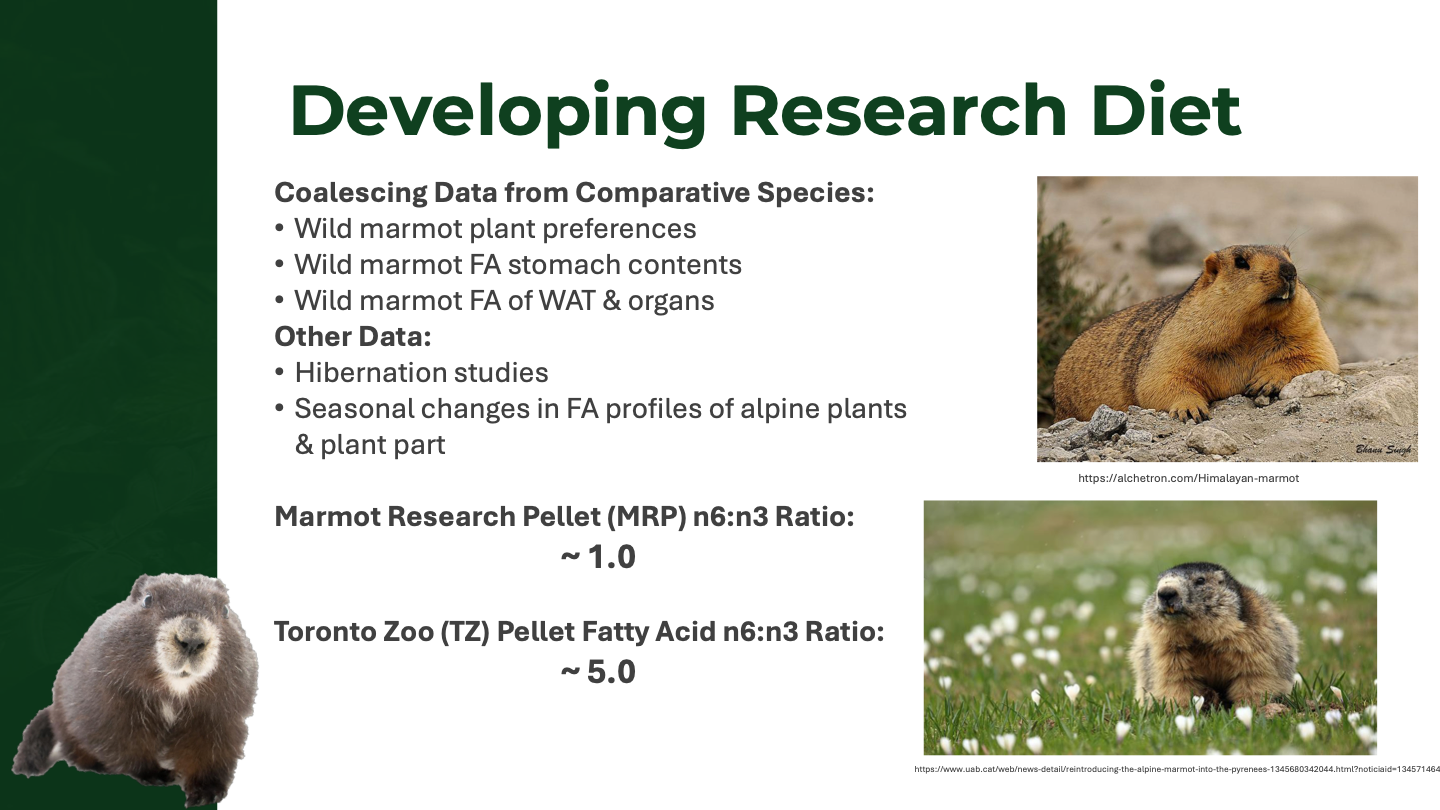
We looked at caloric intake and fatty acid profile. More favourable outcome of FA. Markers linked to cardiovascular disease and ability to breed.
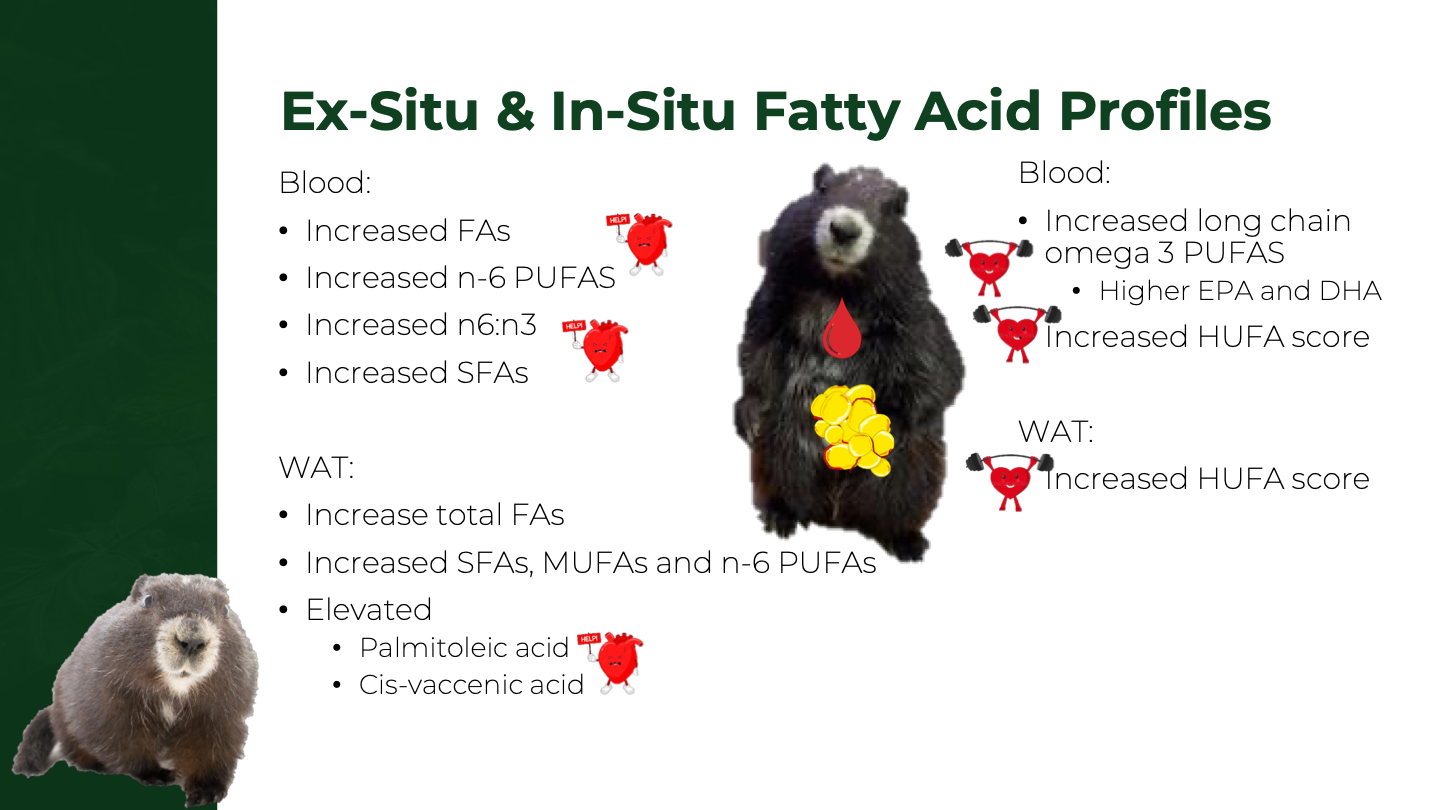
Look at cardiovascular disease markers.
To sample VIM - huge variation in season bias (only 1 fall sample), locations/different plant families changed strategies, females don’t care how fat they get they just keep eating. What nutrients are there from spring to fall. Likely some bias - stayed in one location. Currently setting up, ready to analyze.
EKG readers we can insert and learn from. Heartbeat is important and explains metabolism and disease development. Very messy eaters so it’s hard to study. Hands off in breeding competition - need to study other species to learn about them.
Next steps: look into stable isotopes. What proportion of the things they’re eating and when. DNA barcoding species doesn’t give us huge amounts or numbers, just what is there. What, not proportion. They want to gather wild data and looking at more feeding trails. Look into the real species with improved FA diet (hibernation, FAs blood & WAT, cardiovascular endpoints, bodyweight/composition).
Botanical Gardens
People don’t think about plants the same way as animals. The conservation challenges facing botanical gardens.
Plant Biodiversity
900 mammals, 400k vascular plants. Woody is like a quarter of that. Plant taxonomy is more complicated. Absolutely more plant species to be named.
1.3 million scientific names on World Flora On-like. Various estimates but as many 100k may be at risk now. How do they compare to animals.
Plants tend to hybridize much more freely, causing taxonomical challenges. Plants do not tend to be as sensitive to inbreeding depression. Many plants set seed, a compact natural germplasm storage form. Many plants can be propagated from small tissue samples with ease.
Plants often have obligate ecological partnerships. Plants are dependent largely on abiotic factors like wind, or biotic like bees. Really important ecological partnership. Commensalism relationship with fungi needed in some plants.
Lots of wild plants in Southern Ontario, how people move plants around the road, really changes how people move wild animals. How important plant might be to us in the future will determine plant conservation. We don’t want to lose the plant. Tons of plants exist for traditional medicine. Public perception of plant is remarkably different - plants are seen as the backdrop.
What is the State of the world’s plants - 2020 global review of progress on the conservation and sustainable use of the world’s plants (and fungi).
The botanical garden in London. 25% of species at risk of extinction. Knew links human element and question of why should we care about plants and fungi. We absolutely need them for our own survival. 6 inches of topsoil, fact that it rains would be useless without plants growing in the soil.
Not disturbed randomly - there are hotspots. Individual species level they hang out. Southeast Asia, Mediterranean, black sea, Mexico, Peru, Paraguay, South Africa. Canada doesn’t have much. Glaciers cock block us for years.
North Saskatchewan - glacial refugea, where the glacier didn’t completely cover the landscape. It has the most endemic or unique species, but they’re not endangered. They’re actually doing pretty good. What constitutes an endangered plant species in Canada.
Protecting Species and Habitats
Do we take care of globally endangered species. As endangered as polar bears in Canada. It can only be found in Botanical Nature Sanctuary. Population disappeared about 5 years ago. Our populations are at risk of falling.
Old data, numbers hold up. Status of endangered wildlife in Canada. About half of all list endangered plant species are common somewhere else. Should we care - what species do we choose to work with is hard.
Plants at risk in Canada - Areas of highest biodiversity and highest human impacts. Very important issues on climate change - same conservation for animals and plants. Do you do translocation of species. How does that affect other plants. Just because something is rare, doesn’t mean its endangered. Plant extinction numbers are the same as the animal number.
Red mulberry - most endangered tree. GBIF shows where plants are found historically.
Ontario, where red mulberry are in Toronto. About a ¼ of Canada’s population is around the Royal Botanical Garden.
In conservation trouble because of hybridization. Hybrids between whites and reds. Characterize which maintain genes and which are hybrids. Can’t necessarily identify hybrids based on leaf shape.
Hoary Mountain Mint
Past - discovered in 1981, located on city-owned property adjacent to RBG
Present - initiation of recovery team, composition of a recovery plan, prescribed burns for habitat
Future - partnership with MNR for recovery plan implementation, habitat inventory
Few-flowered Club-Rush (flagship a little)
Past: status report written in 1986, only two locations in Canada. Rouge Valley population now gone
Present: confirmation and documentation of known populations, ongoing demography study to uncover ecology, recovery team formed
Future: recovery plan implementation in partnership with MNR, demography research and habitat characterization, experimental propagation
Plant conservation actions
Special concern species. Grows for several years as a bunch of leaves, than randomly throw up flowers and die. Spreading seed propagule. Work by Parks Canada. Many seeds can be stored overtime. Keep live plants and grow them back out later quite successfully (in like liquid nitrogen) - tissue banks.
In-situ: protection of natural areas, remediation of threats to populations, ecological restoration, population supplementation, habitat connectivity, genetic diversity, pollination and dispersal ecology.
Ex-situ: protection of living plants in cultivation, seed gene banks, tissue banks
Wood-Poppies
Rings all of the criteria for being endangered. Kind of like a turtle - long lived, wild population is declining. Native species is kept in forest.
All four COSEWIC criteria apply
Under 600 wild plants in total in Canada
Known groups in decline
Perennial, herbaceous poppy native to deciduous forests
In horticultural trade for woodlnad gardens, provenance unknown but thought to be USA. May be spreading in some areas.
Did not come from birds, winds, or eaten, could be indigenous people. It being around rivers makes senses as they are like highways.
Habitat loss is the worst part of all that
Variety of definitions - no standard for what constitutes a botanical garden. Collections may be done for MANY different reasons. Try to explain what plants are being used for and how they’re being dealt with today.
Botanical Gardens in Focus - Public Display or Conservation
Botanical Gardens are institutions holding documents collections of living plants for the purposes of scientific research, conservation, display and education. BGCI - global not for profit network. Organized as plant NGO.
Botanical Gardens - Individual records. Millions of these in botanical garden. BGCI has discovered. Different from what happens. Big proportion. Herbium - dried pressed plant specimens. RBG are ecological processes.
3790 BGs in 153 countries. Greater than 6 million living plant accessions. BGCI database includes 1.5 million collection records, 6019k taxa. Greater than 80k living plant species. BG herbaria contain over 142 million specimens.
Herberia put together in Italy. He invented the idea - Orto Botanico di Padova, 1545. Idea caught on.
18th century, they made it to the English speaking world.
The Botanic Garden, Oxford - Trying to be maintained, lots of older ones.
Lab Gallery, Rice Center, Chicago Botanic Garden - Reminiscent of features of the TZ. Central hallways. They try to show what they’re doing.
Green Roof, Rice Center, Chicago Botanic Garden - Edges of the roof
You wouldn’t build a botanical garden in an area without people. Some do scientific research, some exchange seeds, some do plant labeling.
Keeping plants in cultivation
If you can propagate, flowers are critical for identifying.
Winter is a desert. Are they viable. Seed banks are a very good thing. Site was selected.
National Botanic Garden of Ireland - At the facility in Dublin, they were trying to figure out the Potato Blite. The only people trying to figure it out.
RBG’s Endangered Species
Plants in Cultivation - IUCN-listed and CITES species at Risk, Rare Horticultural Cultivars
Wild Species in Nature Sanctuaries
Plants in cultivation which are discovered. We have about 78 species on the IUCN red list for plants. Cactus are in trouble. One plant is extinct in the wild. State of Georgia - so little of it, but they took it into captivity because it was beautiful. Grown at 100 of botanical gardens, but it’s extinct in the wild.
CITES - plants being traded commercially, trade contributes to situation. Animals that get poached, most orchid. A bunch of those are cactuses. We have over 50 wild species listed. Endangered birds and stuff. We have endangered freshwater mussels. When there’s endangered bivalve mollusk, people don’t care as much as they would for a bird or a plant.
Viable captive populations - the numbers game
Laboratory, jars on shelf. Need good temperature, many seeds can last for many years. Each seed is a genetic individual. If the species has two sets of chromosomes, the seed will. Millenium seed bank.
See facility in operation at Millenium seed bank in the UK.
In RBG Edinburgh - not much diversity on individual level. Created as main feature, rather than side piece.
Big difference between Zoo conservation and Botanical Gardens - Much less emphasis on genetic diversity among botanical gardens collections. Only recently has Studbook approach been taken for a key species.
Studbooks publish information about key identifies and information for key species (expand on definition)
Returning plants to the wild
Wetlands - planting cattails in the marsh
Wild rice is very important culturally for first nations in Ontario. Wonderful demonstrations of traditional stuff with the plant. We add it and it expands naturally.
Educating the public
Being in contact with the public is important and is an opportunity to really show people things since they’re coming in already perceptive to that.
Perception and Awareness - the average North American can recognize 10 native plant species and 1000 corporate logos.
Conservation Continuum
Intrigue and excite (marketing message)
Entice and Seduce (enrich the visitor experience)
Enrich and inform (education - how it all works)
Caution and Forwarn (education - why we’re concerned)
Equip to make a difference (providing tools)
Building up Kentucky coffee tree - moved around by giant tree sloths
Elm recovery project by Guelph Arboretum - Recovery of the American Elm after an invasive insect ruined things
Turning Botanical Gardens into Conservation Centres
1986 - IUCN BG specialist group formed
1989 - botanic gardens conservation international formed (BGCI)
1999 - World botanical congress called for global strategy for plant conservation
2002 - UNC on Biological Diversity approves GSPC
2023 - Kunming-Montreal Global Biodiversity Framework
2024 - New GSPC targets under KMGBF
BGCI - Botanic Gardens Conservation International (BGCI)
1987, 600 GB members in 110 countries.
Developing BG policies and practices (plant conservation, environmental education, and sustainable development)
Organizes triennial global botanic gardens congresses
North American Botanic Garden Strategy for Plant Conservation
Organize amount of BGs. Having been involved, we are suspicious. Unless there is a consistent effort to follow up, we don’t know if the strategy actually did anything.
Regional summary of BG contributions + targets important to North America
Ecological Restoration Alliance of BGs (ERA-BG) launched in 2012.
May include megafauna at BGs (Bald Eagles nesting at RBG)
Conservation Social Science & The Future of Zoos
Biodiversity conservation policies are most effective when based on up-to-date scientific knowledge and public buy-in, but most zoos are still susceptible to taxonomic biases that affect how conservation money is spent, which can make it difficult to spend the money on areas where it is most needed.
Ways to rethink captive breeding:
While captive-breeding animals for conservation purposes, plan to minimize the number of generations a species spends in captivity and stick with this timeframe to reduce the changes of drift, inbreeding depression, and adaptation to captivity.
Identify the main goal of captive-breeding - is it for conservation purposes or to have more animals for display purposes?
Come up with clear, scientifically-validated, criteria to identify viable populations for conservations and publish these criteria
According to these authors, if zoos use a triage approach while identifying target species to spend money on, we should focus on species that are extinct in the wild and for whom sufficient numbers exist in captivity to successfully breed.
Earlier in this textbook, we learned about a trigger approach for conservation called the approach, which focuses conservation efforts on species that are evolutionarily distinct and also at high risk of extinction (hint: chapter 2, also discussed in lecture). Another trigger, which was also introduced earlier and is discussed in greater detail in chapter 9, is the approach, which aims at preventing extinctions by conserving any sites which are the last refuge for one or more EN or CR species.
The Future of Zoos
The extinction crisis - IUCN has identified 47k+ SAR - half are likely to be extinct by the end of the century
Average population size of wildlife is 73% shrunk
Freshwater populations have suffered the heaviest declines, falling by 85%, followed by terrestrial (69%) and marine populations (56%).
We need to put a dollar value on biodiversity
Agriculture industry is worth billion of dollars
The Canadian Seed Bank can maintain genetics, loss of biodiversity and habitats, and species that help us and the planet. Need to make saving biodiversity and economic benefit. Loss of biodiversity will impact every single person on the planet.
Model of loss of biodiversity and economic loss
To preserve worlds vital crops in case of catastrophe. Global species populations. Zoo is ahead of the game, coming up with national biobanking strategy here and around the world.
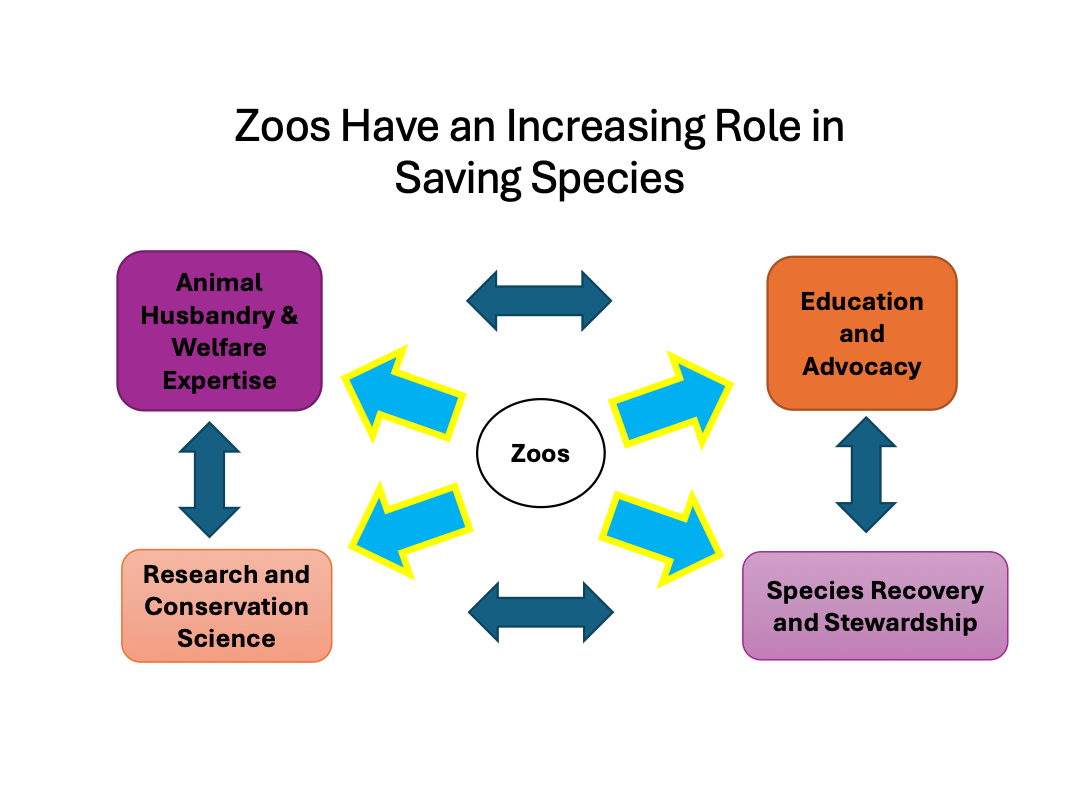
Animal welfare is a key. Orphaned and displaced animals pop up all over due to illegal pet trade. Husbandry and vet care were built over the years, applied to caring for species in their home country. Education and advocacy - what’s going on but also what they can do. Introduce conservation into everything.
Future zoo needs to be ambitious, innovative, and dynamic - they need to grow their community base to work together for conservation action.
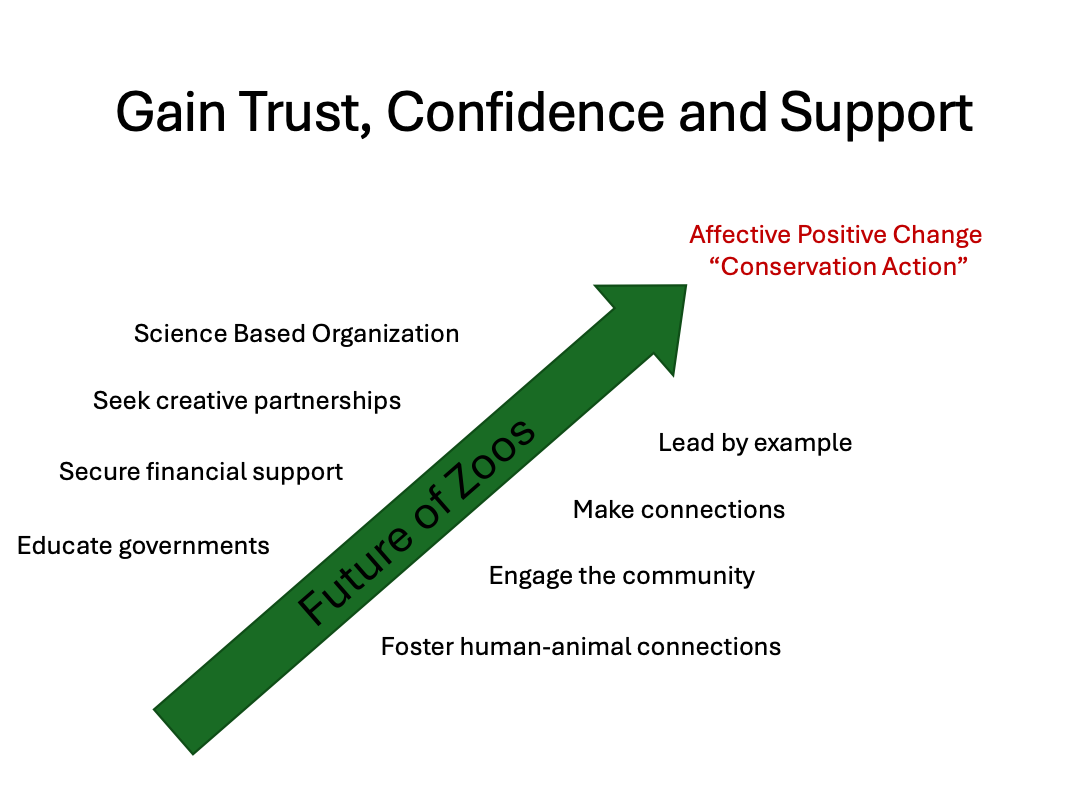
Zoos need to gain trust and stuff. We need to get hidden zoo and where conservation is working where the average person understands what zoos are doing.
We want to get governments on the same page, make connections and engage with the community. Animals and creatures are unbelievable, tingle in the back of the neck. Where can you go to actually see and smell wonderful animals on this planet. Better at increasing.
Zoos are a destination and need to be more focused on many different aspects (animal welfare, sustainability, fewer species, immersive habitats, connecting people with nature). Every species needs a reason. Whether it’s cool or needs help.
Good messaging in a good way at zoos is important.
Get on the radar of leaders in Biodiversity. The hidden zoo needs to be better advertised. Partner with communities, integrate more formal information, be seen as leaders.
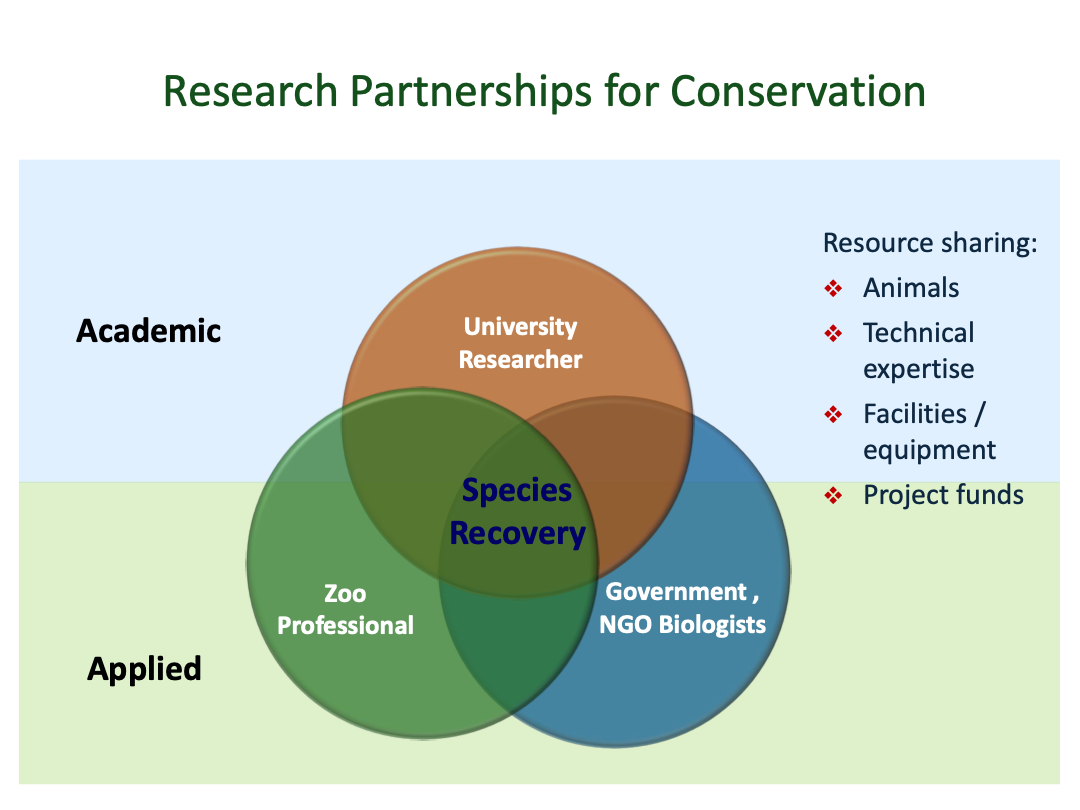
Academic and applied combinations. Animals are in a controlled environment - studied, attached tracking collars to see what works, what fits best. Reindeer, check radio collars.
TZ Community Conservation Centre - increasing partnership. Students can come and learn, work collaboratively on research and all that.
IUCN Position Statement
Care, knowledge, and management of ex-situ and in-situ populations of animals, fungi and plants and their environment
Health and pathology
Conservation translocations
Ethical research, science and data
Working with communities
Capacity building and resources
Toronto Zoo Reverse the Red Hub National & Global - Global movement that ignites strategic cooperation and action to ensure the survival of wild species and ecosystems
Halt extinctions
Reverse declines shown on the IUCN Red List of Threatened Species
Restore populations
Doing extensive work with bats. 8 in Canada, most suffer from white nose syndrome making them endangered. 5 year partnership program. IUCN conservation hub, and other species.
The IUCN Model → Assess, Plan, Act
Is there a habitat for this? Takes a long time. Reintroduce ferrets, listed as extirpated, in first conservation it took 6 years of planning before putting a black footed ferret on Canadian soil in national park.
Right now there are recent trial release - emerging now from hibernation. A lot of SSPs - part of program maintaining healthy genetic population, the successful releasers in America want the genes. Marmots and Caribou are threatened and reintroduced.
Field Conservation: safe programs, saving animals from extinction. Work with ex-situ and safe programs do stuff to save it in the wild. US, Indonesia, South Africa, and Canada.
Mission-Focused Research: the more we learn, more publishing we do, more information sent around the world
WAZA - huge amount of people go to zoos, giving us the opportunity to educate, inform, and empower guests on what they can do. If every zoo gave 2-3% of operating budget to conservation, it could easily be over one billion USD a year.
Toronto Zoo’s strategic plan: from place to purpose. A guest funded zoo with conservation science programs to community funded conservation science organization operating a world class zoo.
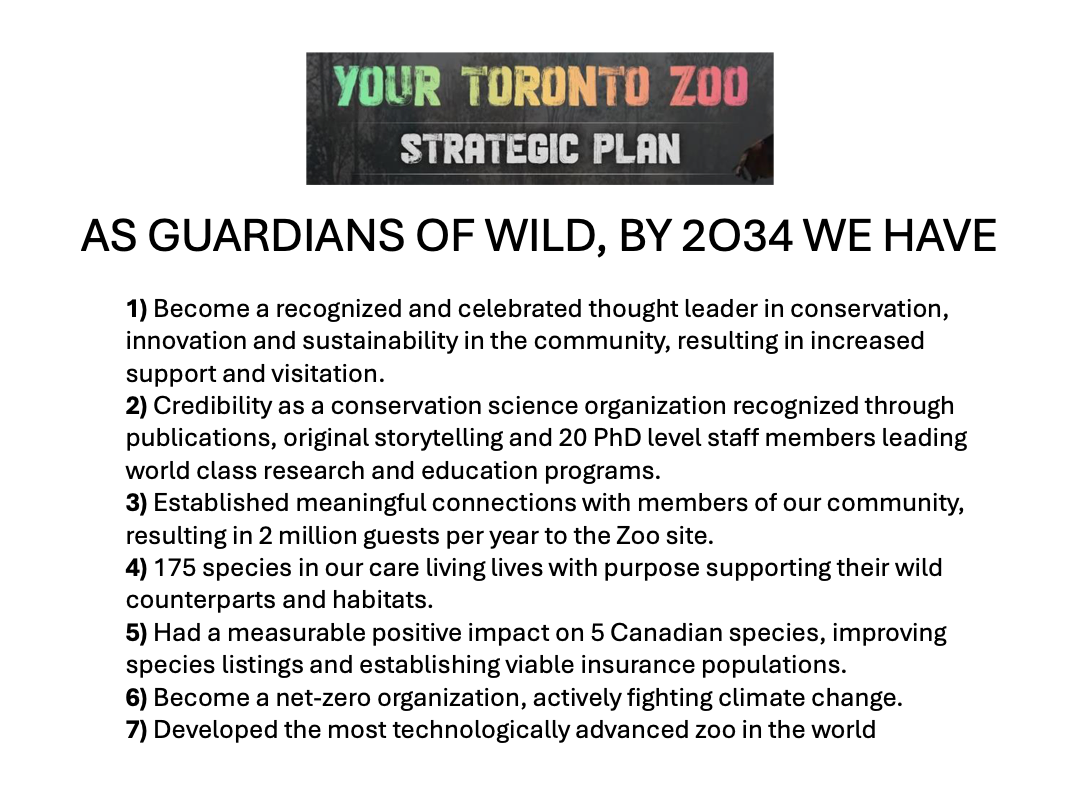
Conservation Social Science
Try to educate and shape attitudes and behaviour. Humans are not objective trust seekers. We can understand social psychology to increase the effectiveness of messaging.
Objectives:
Gain understanding of conservation social science and why it matters
Examine how human behaviour and conservation messaging interact
Look at tools and strategies to increase effectiveness of conservation outreach goals
We want to influence and gather attitudes
LOGIC and EMOTIONS are our key influences
Humans are capable of logic - incredible ability
Emotional centres control decision - damage to it stops ability to pick clothes
Logic - correct reasoning and interferences. Establish truth and validity through structured arguments and deductive reasoning.
Emotion - humans tend to make decisions emotionally and rationalize them post hoc
Intuition - favours coherence over ambiguity, may cause us to be illogical, evolutionarily logical.
Tends to fall into emotion. If we process everything critically we wouldn’t be able to fulfill daily task.
Choose 1 million pennies today or 1 today, 2 tomorrow, 4, 8, 16. We can’t intuitively understand exponential growth.
Likeable people are more like to make people receptive. We like those perceived as similar to us. People are more persuaded by likability than good argument. We may like people more if they look or are similar to us. Science communication doesn’t use jargon and heavy language to connect. More persuaded by likability than good argument. I flew 20 hours and not once did I go upside down. People believed Shaquille O’Neal.
Trust - The Rock is a likeable celebrity - hangs out with sea lions. Honest Abe was a persuasive lawyer. We can lose stuff when things are more aligned with our political beliefs already. Zoos aren’t perfect, but they’re important.
Building trust - Feel good accepting message from someone we trust
Loss of trust - If statements determined to be influenced by external cause (biased)
Persuasion and manipulation - influence the attitudes or behaviour of individuals toward the interest of initiator. Manipulation involved ill-intent.
Attitudes - how can we change them
Feelings about an object or topic that can be strengthened or weakened by talking or thinking about subject. Some topics will be met with stronger attitudes.
Changing attitudes
Spontaneous - more passive and in a positive environment. Get to see animals close up. Get the message across.
Thoughtful - cognitive elaboration, how does it relate to worldview, connects more to goal
There are weak attitudes or strong attitudes. Thoughtful makes it so you need to work through logic.
Cognitive dissonance = feeling of discomfort while contemplating conflicting ideas, can motivate us to change. Create when we get them to contemplate conflicting ideas.
Belief is that I love my cat and she likes to go outside so I won’t lock her in, but the message is that roaming cats are devastating wildlife.
We can resolve dissonance by accepting the message and having a behavioural change, or by rejecting message
Confirmation bias - look for information which affirms existing beliefs and dismisses that which doesn’t. Uncertainty is scary, people aren’t inclined to change beliefs.
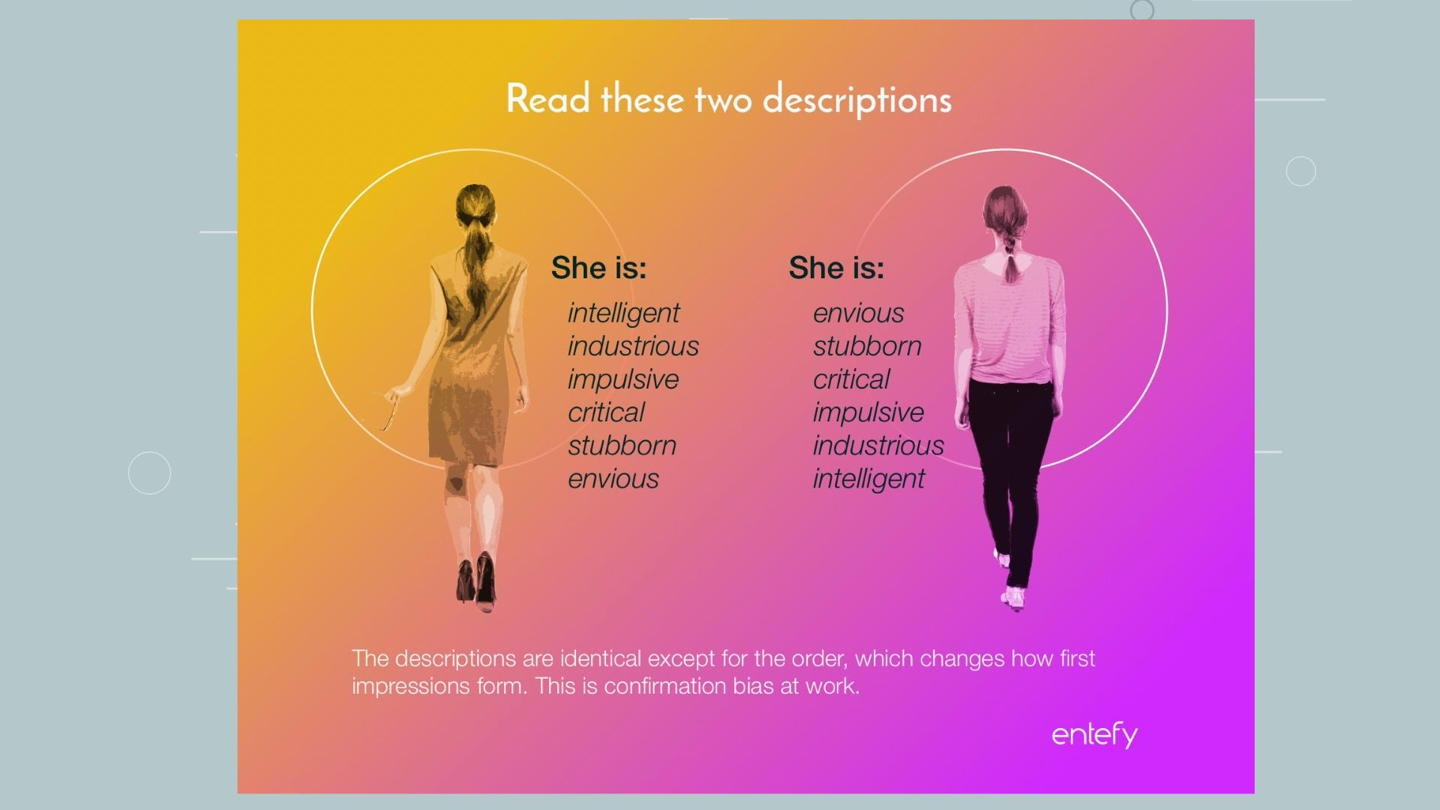
Psychological reactance - strong emotional response experienced when our freedom of choice is removed. Can occur when message is delivered in an overbearing way. Can lead to engagement in opposite behaviour. Richard Dawkins “you can’t honestly believe that” - said to someone who honestly believed that.
Emotional numbing (bumming people out) - sometimes inherent for difficult topics, inundating people with too much concern leads to emotional numbing, apocalyptic analogies may elicit apathy. Well, there’s nothing I can do anyways.
Celebrating victories - Vulture crisis where they were consuming cattle carcass, and the they were wiped out. over 90% in 10 years gone. Bald eagle contaminant was added in. Bald eagles made a comeback.
Framing - A description, analogy or story which helps to give meaning to message - Storytelling is effective for scientific communication. Hook, problem, climax, connect the dots, end. Don’t just spot facts.

Don’t skip steps.
Theory of Planned Behaviour
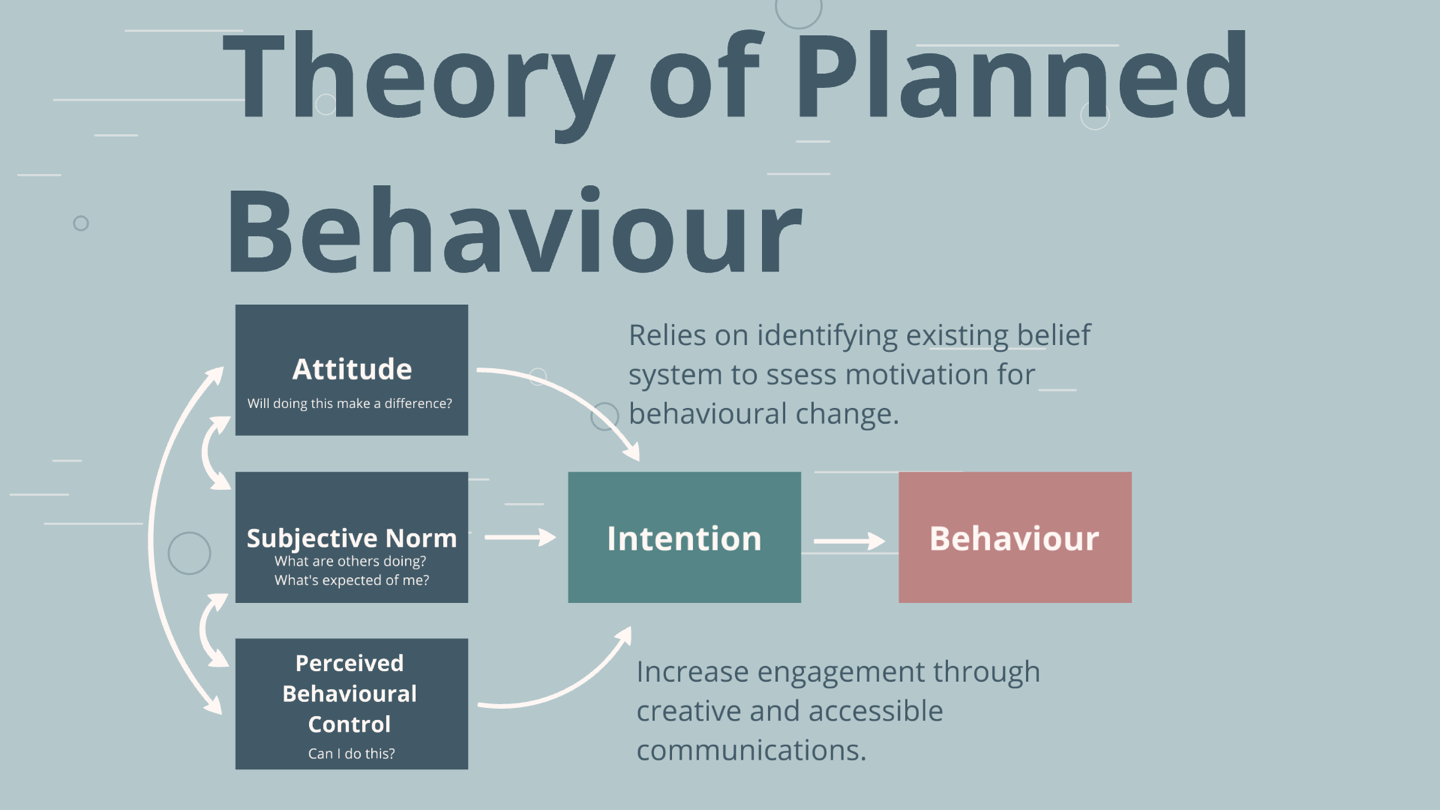
Identify existing belief systems. Identify attitude toward behaviour, they may wonder about subjective norms. Attitudes and behavioural controls. People think it’s natural for cats to hunt birds. Address one or more belief system, maybe compare domestic cats to a tiger.
Get a cat-io. Put cat outside in a cage, walked it on a leash. We want to change attitudes, lead to people keeping cats inside. Some lawmakers banned it.
Conservation science helps understand cognitive dissonance. Tools like framing and theory. Public engagement brings positive conservation impact, greater communication = greater impact.